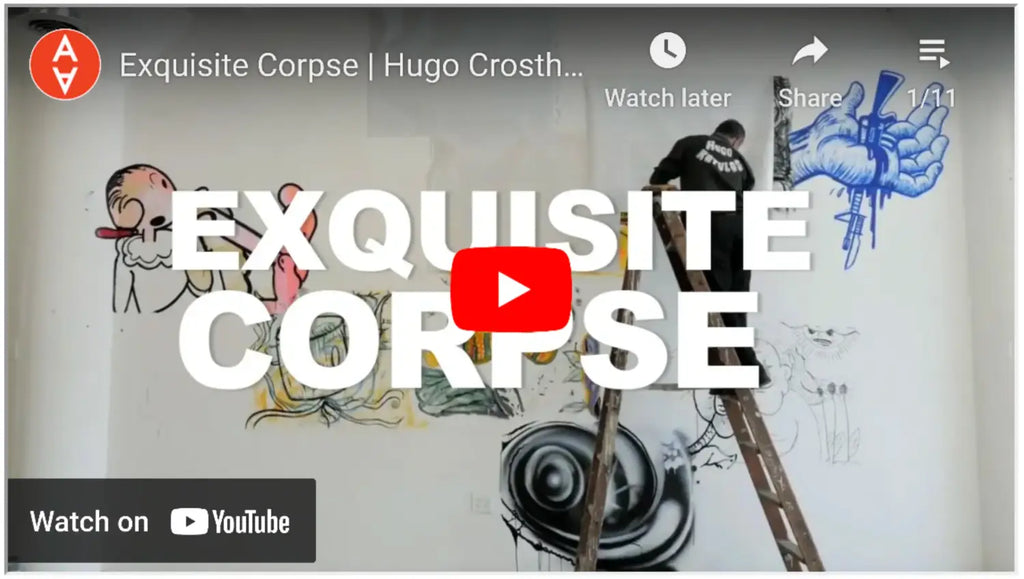不可预测和难忘:精致的尸体艺术的魅力以及如何创建自己的魅力
如果您是超现实主义艺术的粉丝,那么您可能已经听说过精致的尸体技术。这项合作技术是由超现实主义者在20世纪初发明的,是创造意想不到和奇怪的艺术品的一种方式。在本文中,我们将探讨精美的尸体技术的历史,超现实主义艺术家如何使用它以及与朋友一起玩精美的尸体的分步方法。我们还将仔细研究一些最有趣,最著名的精美尸体艺术作品。
精致尸体的历史
- 1925年在巴黎蒙帕纳斯的安德烈·布雷顿(Andre Breton)的住所发明。以及Marcel Duchamp,JacquesPrévert,Yves Tanguy和BenjaminPéret等艺术家。
- 类似于旧的客厅游戏,称为“后果”,玩家依次在纸上写或绘制,将其折叠以掩盖写作或绘画的一部分,然后将其传递给下一个玩家以进一步贡献。
- 布雷顿(Breton)写道,游戏是绕过有意识的思想并利用无意识的创意过程的一种方式。
- 超现实主义者制作了许多精致的尸体图纸,并在整个1920年代和30年代都使用了艺术品和著作中的技术。
Cadavre Eapquisqu,也被称为“精美尸体”,是由法国超现实主义艺术家AndréBreton和他的朋友在1925年发明的一款绘图游戏。这个名字来自“ Le Cadavre Eapquer Eapquip boira boira le vin nouveau”一词喝新葡萄酒”),这是他们玩游戏时创建的第一句话。
该游戏涉及多位艺术家合作创建一个复合图纸或句子,而无需看到彼此的贡献。每个人轮流通过遵循规则或仅允许看到上一个人的贡献结束。这会导致奇怪而意外的并置,因为图纸或文本是有机组装的。
超现实主义者是一群有兴趣探索潜意识和非理性的艺术家和作家。他们认为,通过利用这些领域,他们可以创造出不受传统技术和样式限制的新形式的艺术形式。精致的尸体技术是超现实主义者合作并创造意外且奇怪的艺术品的一种方式。
超现实主义艺术家如何使用精美的尸体
超现实主义者以多种方式使用了精美的尸体技术。一些人将其用作创建图纸或绘画的一种方式,而另一些则将其用来创作诗歌或故事。该技术通常被用作游戏,超现实主义者轮流为艺术品或故事做出贡献。由此产生的作品通常是奇怪而荒谬的,反映了超现实主义者对非理性和潜意识的兴趣。
超现实主义运动的领导者安德烈·布雷顿(AndréBreton)创作了最著名的精美尸体艺术品之一。 1938年,布雷顿组织了一场精致的尸体游戏,其中要求参与者创建女性的图画。由此被称为“ Cadavre精美”的作品是一系列四个图纸,显示了该女性身体的不同部分。每个图纸都是由另一个艺术家完成的,最终结果是对女人的超现实和色情描述。
如何与朋友一起玩精美的尸体
与朋友一起玩精美的尸体很容易有趣。这是一种逐步的方法:
- 聚集一群有兴趣玩精美尸体的朋友。
- 确定将使用的介质(例如绘画,绘画,写作)。
- 决定艺术品或故事的主题或主题。
- 确定每个人将贡献的顺序。
- 每个人首先要贡献艺术品或故事的一部分,而没有看到其他人的贡献。
- 将艺术品或故事传递给下一个人。
- 每个人仅根据上一个人的贡献而增加艺术品或故事。
- 重复步骤6和7,直到艺术品或故事完成为止。
重要的是要注意,精致的尸体是一种协作技术,因此保持开放的思想并愿意放弃最终结果很重要。目的是创造出意外且不可预测的东西,因此不要害怕冒险并发挥创造力。
精致尸体艺术的著名作品
现代超现实主义和当代艺术家创作的精致尸体艺术有许多著名的作品。现代大师的这三个例子可能并非全部遵循传统的精美尸体格式,但它们有助于证明该游戏在现代艺术家心中的影响力。
以下是一些有趣的尸体艺术的有趣例子:
安德烈·布雷顿(AndréBreton)
如前所述,“ Cadavre Eapquis”是最著名的精美尸体艺术品之一。它是由安德烈·布雷顿(AndréBreton)于1938年创建的 由安德烈·布雷顿(AndréBreton),努斯·埃鲁德(Nusch Eluard),瓦伦丁·雨果(Valentine Hugo)和保罗·埃鲁德(Paul Eluard) k从床单背面的铭文中,在安德烈·布雷顿(AndréBreton)的手中。艺术品是一系列四个图纸,描绘了女人身体的不同部位。每个图纸都是由另一个艺术家完成的,没有看到其他艺术家的贡献。 p泰特收藏的艺术,它是在纸上使用石墨制成的.
曼雷(Man Ray)
这部精致的尸体艺术品是由1927年的美国艺术家曼·雷(Man Ray)创作的。这是一系列四张照片,显示出扭曲的人脸。这些照片是通过在不使用相机的情况下折叠和操纵一张摄影纸来创建的。
Max Ernst的“精美尸体”
这款精致的尸体艺术品是由Max Ernst在1926年创作的。这幅画展示了具有奇怪生物和物体的超现实风景。这幅画是通过将不同的图像拼贴在一起而不考虑传统观点或构图而创建的。
YouTube上精致的尸体
...
精致的尸体技术是一种有趣而独特的方法 创造艺术。它使艺术家和作家能够合作,创作出意想不到的,不可预测的作品,反映出对非理性和潜意识的超现实主义兴趣。通过遵循本文概述的分步方法,您可以与朋友一起玩精美的尸体,并创建自己的超现实和奇异的艺术品。
—




